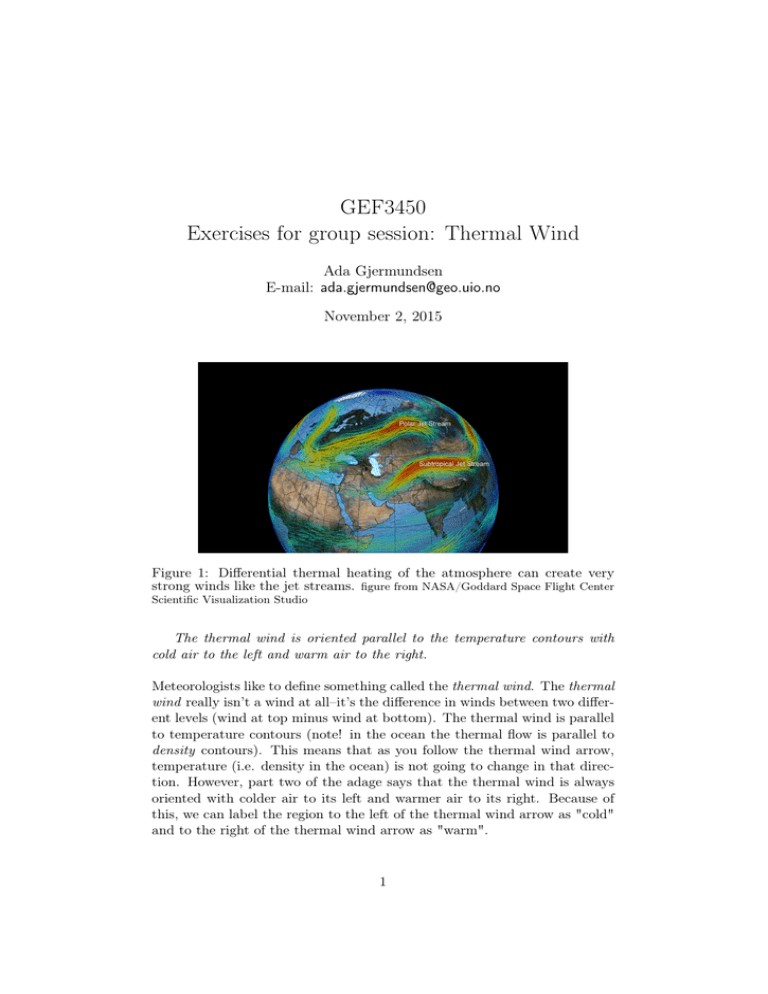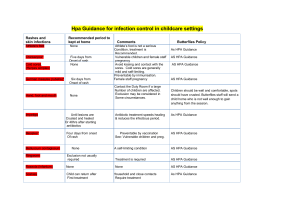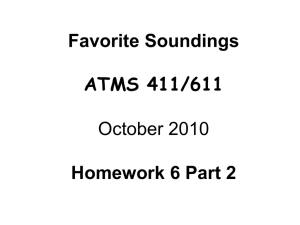GEF3450 Exercises for group session: Thermal Wind Ada Gjermundsen E-mail:
advertisement

GEF3450 Exercises for group session: Thermal Wind Ada Gjermundsen E-mail: ada.gjermundsen@geo.uio.no November 2, 2015 Figure 1: Differential thermal heating of the atmosphere can create very strong winds like the jet streams. figure from NASA/Goddard Space Flight Center Scientific Visualization Studio The thermal wind is oriented parallel to the temperature contours with cold air to the left and warm air to the right. Meteorologists like to define something called the thermal wind. The thermal wind really isn’t a wind at all–it’s the difference in winds between two different levels (wind at top minus wind at bottom). The thermal wind is parallel to temperature contours (note! in the ocean the thermal flow is parallel to density contours). This means that as you follow the thermal wind arrow, temperature (i.e. density in the ocean) is not going to change in that direction. However, part two of the adage says that the thermal wind is always oriented with colder air to its left and warmer air to its right. Because of this, we can label the region to the left of the thermal wind arrow as "cold" and to the right of the thermal wind arrow as "warm". 1 Figure 2: Ada’s handwavy sketch of thermal wind This fancy feature of the thermal wind makes it useful for diagnosing temperature structures based on winds, or the other way around: calculate wind profiles based on pressure or temperature measurements from different heights in the atmosphere. It’s amazing how everything is connected! Most of the text is taken from Luke’s weather blog: http://lukemweather.blogspot.no/ The Thermal Wind Balance: There are several different versions of the thermal wind equation. For the atmosphere it is common to use the temperature gradient at constant pressure surfaces to calculate the thermal wind ~ug g = − k̂ × ∇p T (1) ∂p fp R p0 ~uT = ~u(p1 ) − ~u(p0 ) = ln ]k̂ × ∇p T (2) f p1 while in the ocean it is more common to consider changes in density (since the thermal wind is parallel to density contours in the ocean) ~ug g =− k̂ × ∇ρ ∂z f ρc ... but don’t panic if you see other versions - they all describe the same phenomenon:-) 2 (3) Exercises: Exercises from “Fluid Mechanics” by Kundu and Cohen, “Atmosphere, Ocean and Climate Dynamics” by Marshall and Plumb, “Atmospheric Science” by Wallace and Hobbs, “Dynamic Meteorology" by Holton and “Geophysical Fluid Mechanics” by Weber. 1 The mean temperature in the layer between 750 hPa and 500 hPa decreases eastward by 3◦ C per 100 km. If the 750 hPa geostrophic wind is from the southeast at 20 ms−1 , what is the geostrophic wind speed and direction at 500 hPa? Let f = 10−4 s−1 . 2 What is the mean temperature advection in the 750 − 500 hPa layer in problem 1? 3 Suppose that a vertical column of the atmosphere at 43◦ N is initially isothermal from 900 hPa to 500 hPa. The geostrophic wind is 10 ms−1 from the south at 900 hPa, 10 ms−1 from the west at 700 hPa, and 20 ms−1 from the west at 500 hPa. i) Calculate the mean horizontal temperature gradients in the two layers 900 hPa to 700 hPa and 700 hPa to 500 hPa. (Hint: use the thermal wind eqn.) ii) Compute the rate of advective temperature change in each layer. (Hint: DT Dt = 0 following the wind.) iii) How long would this advection pattern have to persist in order to establish a dry adiabatic lapse rate between 600 hPa and 800 hPa? Assume that the lapse rate is constant between 900 hPa and 500 hPa, and that the 600 hPa to 800 hPa thickness is 2.25 km? (the dry adiabatic lapse rate is 9.8 ◦ Ckm−1 ) 4 ) Fig 3 shows the trajectory of a “champion" surface drifter, which made one and a half loops around Antarctica between March, 1995, and March, 2000 (courtesy of Nikolai Maximenko). Red dots mark the position of the float at 30 day interval. i) Compute the speed of the drifter over the 5 years. (Hint: the distance for one loop around Antarctica at the latitude where the drifter is located is approximately 22 × 103 km) ii) Assuming that the mean zonal current at the bottom of the ocean is zero, use the thermal wind relation (neglecting salinity effects) to 3 Figure 3: From “Atmosphere, Ocean and Climate Dynamics” by Marshall and Plumb compute the depth-averaged temperature gradient across the Antarctic Circumpolar Current (ACC). Hence estimate the mean temperature drop across the 600 km-wide Drake Passage. g ∂ρ (Hint: use the thermal wind equation: f ∂u ∂z = ρref ∂y , the density equation for fresh water ρ = ρref (1−αT [T −Tref ]) where αT = 2×10−4 K−1 is the expansion coefficient and an average depth of 4 km) iii) If the zonal current of the ACC increases linearly from zero at the bottom of the ocean to a maximum at the surface (as measured by the drifter), estimate the zonal transport of the ACC through Drake Passage, assuming a meridional velocity profile as in Fig. 3 πy (u(y, 0) = umax = U0 cos( 2L )) and that the depth of the ocean is 4 km. The observed transport through Drake Passage is 130 SV. Is your estimate roughly in accord? If not, why not? 5 ) Consider a straight, parallel, oceanic current at 45◦ N. For convenience, we define the x- and y- directions to along and across the current, respectively. In the region −L < y < L, the flow velocity is πy z ) exp( ) 2L d where z is height (note that z = 0 at mean sea level and decreases u = U0 cos( 4 Figure 4: From “Atmosphere, Ocean and Climate Dynamics” by Marshall and Plumb downwards), L = 100 km, d = 400 m and U0 = 1.5 ms−1 . In the region |y| > L, u = 0.The surface current is plotted in Fig 4. Using the geostrophic, hydrostatic and thermal wind relations: i) Determine and sketch the profile of surface elevation as a function of y across the current. ii) Determine and sketch the density difference, ρ(y, z) − ρ(0, z). (Hint: g ∂ρ use the thermal wind equation: f ∂u ∂z = ρref ∂y ) iii) Assuming the density is related to temperature by: ρ = ρref (1 − αT [T − Tref ]) (4) determine the temperature difference, T (L, z)−T (−L, z), as a function of z. Use αT = 2 × 10−4 C−1 . Evaluate the difference at a depth of 500 m. Compare with Fig. 4. 6 Fig. 5 shows, schematically, the surface pressure contours (solid) and mean 1000 hPa to 500 hPa temperature contours (dashed) in the vicinity of a typical northern hemisphere depression (storm). The contour interval is 2 hPa for the surface pressure and 2◦ C for the temperature. ”L” indicates the low pressure center. Sketch the direction of the wind near the surface, and on the 500 hPa pressure surface. (Assume that the wind at 500 hPa is significantly larger than at the surface (why?).) If the movement of the whole system is controlled by the 500 hPa wind, how do you expect the storm to move? [Use: density of air at 1000 hPa = 1.2 kgm−3 ; f = 7.27 × 10−5 s−1 ; gas constant for air = 287 Jkg−1 K.] 5 Figure 5: From “Atmosphere, Ocean and Climate Dynamics” by Marshall and Plumb 7 i) From the pressure coordinate thermal wind relationship, (eqns. 3.4546 in the gfd notes), and approximating ∂u ∂u/∂z ' ∂p ∂p/∂z (5) show that in geometric height coordinates ∂u g ∂T '− ∂z T ∂y (6) ii) The winter polar stratosphere is dominated by the “polar vortex”, a strong westerly circulation about 60◦ latitude around the cold pole, as depicted schematically in the Fig. 6. (This circulation is the subject of considerable interest, because it is within the polar vortices - especially that over Antarctica in the southern winter and spring - that most of the ozone depletion is taking place.) Assuming that the temperature at the pole is (at all heights) 50 K colder at 80◦ latitude than at 40◦ latitude (and that it varies uniformly in between), and that the westerly wind speed at 100 hPa pressure at 60◦ latitude is 10 ms−1 , use the thermal wind relation to estimate the wind speed at 1 hPa pressure at 60◦ latitude. (you need the gas constant for air = 287 Jkg−1 K). 6 Figure 6: From “Atmosphere, Ocean and Climate Dynamics” by Marshall and Plumb Solutions: 1 ~ug (500) = (−14.1, −20.4) ms−1 , or 25 ms−1 speed from 34◦ east of north. 2 Mean advection = −~u · ∇T = −u ∂T ∂x , where u = (u500 − u750 )/2 and ∂T −5◦ −1 Cm . Thus, = −~u · ∇T = −4.23 × 10−4◦ C s−1 ∂x = −3 × 10 ∂T ◦ 3 For layer 900 − 700 hPa: ∂T ∂y = ∂x = −1.39 C/(100 km). The average wind is u = v = 5 ms−1 . ∂T ◦ For layer 700 − 500 hPa: ∂T ∂y = −1.03 C/(100 km) and ∂x = 0.The average wind is u = 15 ms−1 and v = 0 ms−1 ∂T ∂T The advective change of temperature change is ∂T ∂t = −u ∂x − v ∂y . −4◦ C s−1 and for the Thus for the 900 − 700 hPa layer ∂T ∂t = 1.39 × 10 700 − 500 hPa layer ∂T ∂t = 0. Thus, the temperature difference between 800 hPa and 600 hPa increases by 1.39 × 10−4◦ C s−1 . Assuming a 2.25 km thickness, we find that an adiabatic lapse rate (9.8◦ C/km) would be established within 44 hrs. 4 i) u = 0.2 ms−1 . ii) The depth average temperature drop is ∆T = 1.5 K iii) 153 SV (observed transport is approx. 135 SV). Note that we have only calculated the transport associated with the thermal wind. 5 6 The storm center should move approximately northeastwards at about 66 ms−1 . 7 ii) Given u100 = 10 ms−1 , we get u1 = 125 ms−1 7





